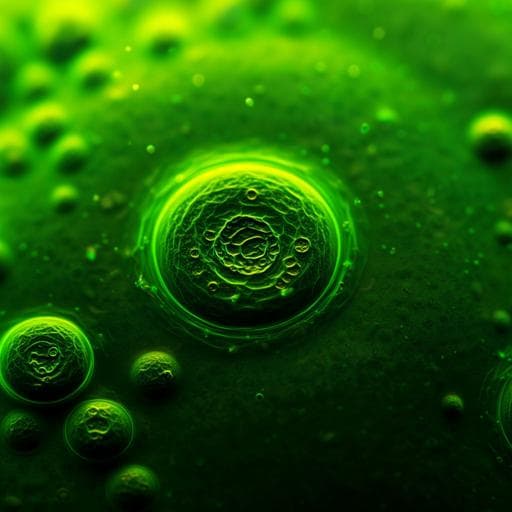
Medicine and Health
Development of spirulina for the manufacture and oral delivery of protein therapeutics
B. W. Jester, H. Zhao, et al.
Discover groundbreaking genetic engineering methods that enable high-level expression of bioactive proteins in the edible cyanobacterium Arthrospira platensis (spirulina). This innovative research, conducted by a team including Benjamin W. Jester and others, demonstrates the potential of spirulina as a biomanufacturing platform for therapeutic proteins delivered safely and effectively through oral administration.
~3 min • Beginner • English
Introduction
The study addresses whether Spirulina (Arthrospira platensis) can be domesticated as a robust platform for manufacturing orally delivered therapeutic proteins. Traditional platforms (E. coli, yeasts, mammalian cells) have limitations in scalability, cost, and post-processing, and plant/algal systems have struggled with slow growth, low yields, and regulatory challenges. Spirulina is commercially cultivated as food, has high protein content, reproduces asexually (reducing gene escape risks), and may offer photosynthetic, scalable production. The authors aim to develop versatile genetic engineering tools enabling stable, high-level expression of exogenous proteins in spirulina, establish cGMP-compatible indoor cultivation and simple downstream processing, and demonstrate functional oral delivery using an anti-Campylobacter therapeutic validated in animal models and assessed for safety in humans.
Literature Review
The authors contrast microbial and mammalian expression systems with plant and algal platforms, noting that while plants offer photosynthetic growth and scalability, they suffer from cumbersome genetic methods, slow growth, low yields, and regulatory barriers. Algae have been explored but are difficult to engineer and often show low and unstable expression of exogenous proteins; no biologic has been commercialized from algal platforms to date. Prior successes in oral biologics include antibodies produced in bovine colostrum and rice-based expression of therapeutics, though scalability and lot consistency remain challenging. Spirulina’s safety record (GRAS status) and use as a food supplement support its potential as a food-based biopharmaceutical production host.
Methodology
- Natural transformation and integration: Demonstrated that spirulina (UTEX LB1926 and NIES-39) is naturally competent when cocultured with companion microbes (Sphingomonas and Microcella). Transformation employed integrating DNA vectors bearing a selectable marker and gene of interest (GOI), flanked by 1.0–1.5 kb left/right homology arms (LHA/RHA), resulting in double-crossover homologous recombination. Genotyping by PCR across junctions and Sanger sequencing confirmed targeted integration. Pools of ~100–300 independent transformants were quantified via NGS using barcoded vectors.
- Segregation and stability: Under continuous selection, segregation to homozygosity in polyploid spirulina occurred in 8–10 weeks. Transgenes remained genetically stable over >800 generations (>3 years) with no sequence changes in tested strains. Single-filament microisolation yielded clonal derivatives; transgene copy number was verified by qPCR.
- Markerless engineering: Identified a native kanamycin resistance locus (KmR; NIES39_RS07765). Strategy: replace KmR with streptomycin resistance gene (aadA), then replace aadA with a cassette containing KmR plus the GOI, yielding markerless integration adjacent to KmR with no other exogenous DNA.
- Expression constructs: Introduced single genes, tandem genes, operons (up to a 6.0 kb seven-gene C-phycocyanin operon) and engineered multiple loci sequentially. Used a strong constitutive promoter from the C-phycocyanin locus (Pcpc600) with TrrnB terminator. Achieved uniform intracellular expression of diverse proteins (bioactive peptides, VHHs, pigments, enzymes), reaching up to ~29.8% of soluble protein.
- VHH formats and scaffolding: Expressed antigen-binding domains (VHHs) as monomers (often fused to solubility chaperones like MBP or TRX) and multimers (dimeric 5HVZ with disulfide, trimeric cTRP, heptameric 4BOF with disulfide). Multimerization yielded subnanomolar apparent affinities; disulfide formation efficiencies in dimeric scaffolds were 50–100%.
- Anti-Campylobacter constructs: FlagV6 VHH (engineered as aa682 variant for protease resistance) targeting FlaA D3 domain. SP526 strain expressed FlagV6-MBP at ~3% of dry biomass (≈8% soluble protein). Binding kinetics assessed by BLI; surface binding to intact C. jejuni measured by flow cytometry; motility inhibition assayed on soft agar.
- Large-scale cultivation: Developed modular indoor vertical flat-panel photobioreactors (160–2,000 L), pH-controlled (>10), air-mixed, illuminated by adjustable LED. Cultures maintained without antibiotics in 1-week cycles; light-limited linear growth at higher density; weekly harvests at ~4 g/L; harvest via stainless steel screens; a portion reinoculated.
- Cost optimization: Determined LED electricity dominates cost (~47%); identified optimal light intensity (~100 µmol m⁻² s⁻¹) for minimal cost per biomass.
- Downstream processing: Rinsed harvested slurry with trehalose and spray-dried. Evaluated drying parameter space; maintained >90% binding activity across optimized conditions. Scaled to 5 kg/h spray-dryer with centrifugal atomization; packaged powder in moisture/light-proof packaging; filled into vegetarian capsules under cGMP (21 CFR 210/211); met USP <1111>, <232> specifications.
- Stability: ELISA-based functional testing showed binding activity retention up to 6 months at temperatures up to 42°C.
- Gastrointestinal delivery studies: Simulated gastric fluid (pH ~3, pepsin 2,000 U/mL) rapidly degraded purified aa682 (within 2 min), but encapsulation in dry spirulina protected >70% intact after 2 h. Transition to simulated duodenal conditions (pH >5–7) released >90% aa682 within 60 min; binding activity preserved.
- Intestinal protease stability: aa682 resistant to constitutive trypsin/chymotrypsin; some sensitivity at postprandial high chymotrypsin levels; binding activity quantified by ELISA after protease exposure.
- Animal models: Mouse models of C. jejuni infection (strain 81-176) received oral spirulina biomass (SP526 or controls) prophylactically; measured fecal shedding (CFU/10 mg feces), inflammatory biomarkers (LCN-2, MPO), and PMN infiltration.
- Clinical trial: Manufactured SP1182 (markerless aa682-expressing strain) as LMN-101 for phase 1 in healthy adults (18–50 years). Doses up to 3,000 mg biomass three times daily; monitored safety, labs, adverse events, and serum VHH (PK). Identity and sequence of aa682 confirmed by LC-MS intact mass and peptide mapping (98% coverage).
Key Findings
- Natural competence and engineering: Spirulina exhibits natural transformation when cocultured with companion microbes; homologous recombination via double crossover integrates GOIs with ~100–300 independent events per transformation. Transgenes segregate to homozygosity in 8–10 weeks and remain stable >3 years (>800 generations).
- High-level expression: Using Pcpc600 promoter, exogenous proteins achieved up to 29.8% of soluble protein. Multiple VHH constructs reached 0.7–29% of soluble protein.
- VHH multimerization boosts affinity: Dimerization reduced EC50 from 18.3 nM to 0.32 nM with purified protein, and from 52.3 nM to 1.29 nM in spirulina extracts (RBD-binding VHH ELISAs).
- Anti-Campylobacter VHH expression and function: SP526 expressed FlagV6-MBP at ~3% dry biomass (~8% soluble). BLI measured aa682–FlaA binding with KD ≈ 53 nM (ka = 4.5×10^5 M⁻¹ s⁻¹; kd = 2.4×10⁻² s⁻¹). Flow cytometry confirmed binding to intact C. jejuni; motility halos significantly reduced vs controls.
- Mouse efficacy: Prophylactic oral SP526 reduced fecal C. jejuni shedding by 3–4 logs and lowered intestinal inflammation biomarkers (LCN-2, MPO) versus vehicle and irrelevant controls; no diarrhea in treated mice versus universal diarrhea in controls. A single dose as low as 2 mg biomass (≈60 µg VHH; ~10⁻⁸ M in mouse small intestine) was effective; accelerated pathogen expulsion at 24 h and reduced shedding at 72 h; reduced PMN infiltration.
- Manufacturing and stability: Indoor photobioreactor system achieved weekly harvests at ~4 g/L without asepsis; spray-dried biomass retained >90% VHH activity under optimized conditions and remained functionally stable at up to 42°C for at least 6 months.
- Oral delivery performance: Bioencapsulation within dry spirulina protected >70% aa682 from gastric pepsin over 2 h; >90% release within 60 min at duodenal pH with minimal loss of binding activity; aa682 showed resilience to intestinal proteases at constitutive levels.
- Clinical safety: Phase 1 (LMN-101) in healthy adults up to 3,000 mg biomass TID demonstrated safety and tolerability, with only grade 1 adverse events comparable to placebo and no laboratory abnormalities; no systemic absorption of VHH detected, as expected for an oral nonabsorbed biologic.
- Cost optimization: Electricity for LEDs accounted for ~47% of production cost; an optimal light intensity (~100 µmol m⁻² s⁻¹) minimized cost per unit biomass.
Discussion
The findings establish spirulina as a genetically tractable, stable, and high-productivity platform for orally delivered therapeutic proteins. By leveraging natural competence and markerless chromosomal integration, the system supports constitutive expression of diverse bioactives at high levels, including multimerized VHHs with enhanced apparent affinity. The platform’s photosynthetic growth, tolerance of high pH and salinity, and operation in sanitary (non-aseptic) indoor photobioreactors simplify large-scale manufacturing. Spray-dried spirulina enables room-temperature stability and protects cargo proteins during gastric transit, ensuring delivery and activity in the intestine. In vivo mouse studies validate efficacy of an anti-Campylobacter VHH expressed in spirulina, demonstrating substantial reductions in pathogen burden and inflammation after oral dosing. A first-in-human trial confirms safety and lack of systemic absorption, supporting the intended local GI mechanism. Compared to conventional platforms (e.g., CHO cells for full-length mAbs), spirulina cannot produce glycosylated or complex disulfide-rich proteins but offers simpler infrastructure and no purification for oral delivery, potentially enabling cost-effective prophylaxis and treatment in resource-limited settings. The platform is well-suited for multicomponent biologic cocktails targeting complex diseases and variable pathogens, potentially overcoming limitations of systemic biologics such as off-target toxicity and delivery to mucosal sites.
Conclusion
This work introduces comprehensive genetic engineering and cGMP manufacturing methods for spirulina, enabling stable, high-level expression of therapeutic proteins and simple, purification-free production of orally delivered biologics. The anti-Campylobacter case study demonstrates functional efficacy in animal models and safety in humans, with biomass-encapsulated VHHs protected during gastric transit and active in the intestine. The spirulina platform’s scalability, stability at ambient temperatures, and simplified upstream/downstream processes position it as a promising system for affordable prophylaxis and treatment of enteric and other mucosal diseases. Future research should optimize volumetric productivity, expand therapeutic repertoires (within non-glycosylated, limited-disulfide constraints), evaluate efficacy in human clinical trials for specific indications, and develop multicomponent biologic cocktails targeting complex diseases and variable pathogens. Exploration of delivery to other mucosal sites (e.g., upper airway) and oral vaccines represents further directions.
Limitations
- Platform constraints: Spirulina, as a prokaryote, cannot perform human-like glycosylation or efficiently express proteins requiring multiple disulfide bonds, limiting the class of therapeutics amenable to this system.
- Evidence base: Many expression and binding/stability assays were performed once or with limited replicates; efficacy demonstrated in mouse models but not yet in human efficacy trials.
- Transformation dependency: Induction of natural competence required coculture with companion microbes; details of competence regulation and broader applicability across strains may require further study.
- Productivity benchmarking: While high potency per biomass is shown for VHHs, volumetric productivity remains below mature CHO processes for full-length antibodies and warrants further process optimization.
Related Publications
Explore these studies to deepen your understanding of the subject.







